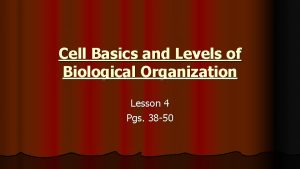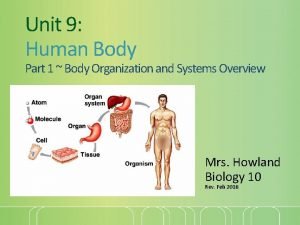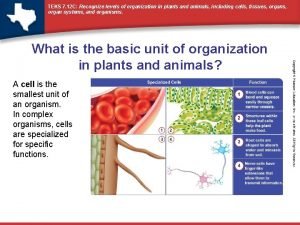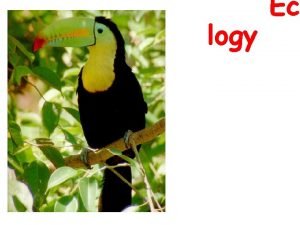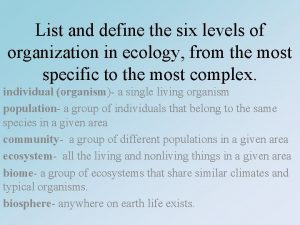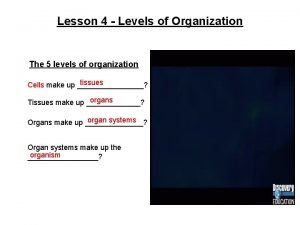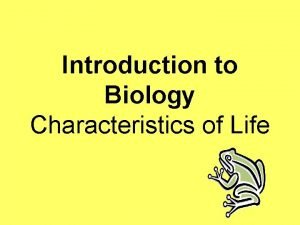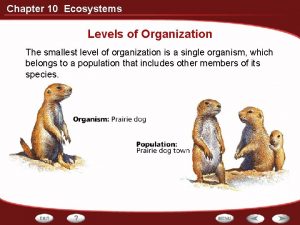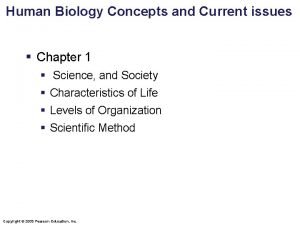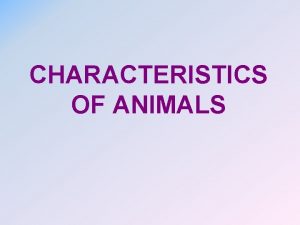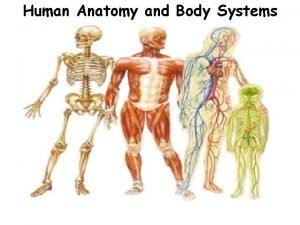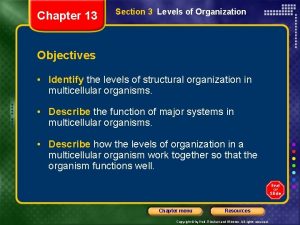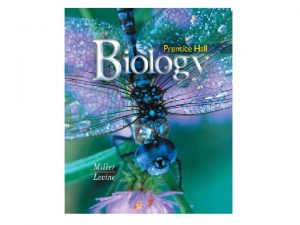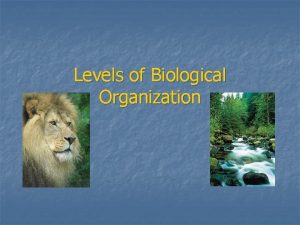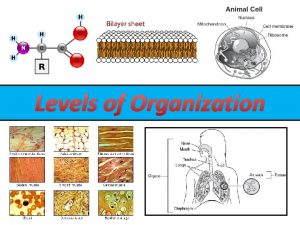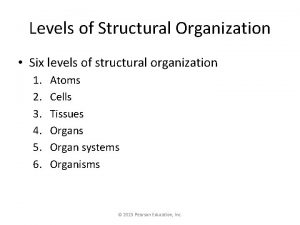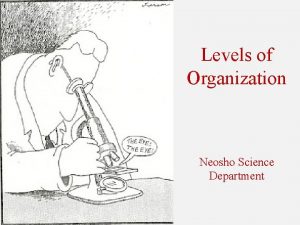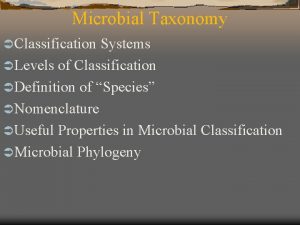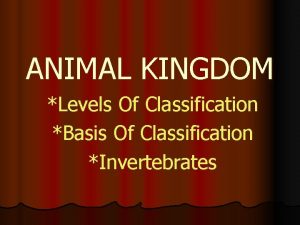Classification and Levels of Organization Lesson 3 Standards












































- Slides: 44

Classification and Levels of Organization Lesson 3

Standards for this unit • SPI 0807. 5. 1 Use a simple classification key to identify an unknown organism.

Terms to know: • • • Classification Taxonomy Morphology Kingdom Species Phylum • • Class Order Family Genus Trait Dichotomous key Binomial nomenclature

What You Will Learn: • Organization makes things make sense. • What if our school was not organized? Imagine if you could go to any class with any kids. • Chaos. • Scientists organize the millions of known organisms based on what they have in common.

Species of Organisms • There are 13 billion known species of organisms • This is only 5% of all organisms that ever lived. • New organisms are still being found and identified. • How do we handle all this? copyright cmassengale 5

Taxonomy • Grouping objects based on what they have in common is called classification. • The science of identifying, classifying, and naming living things is called taxonomy. • An organism’s structure is its morphology.

Classification • The classification of organisms helps scientists these questions: • How many species are there? • What are the characteristics of each organism? • What are the relationships between species? • Why do we need to know this info?

Let’s try classifying! • You can classify the objects in your bag in any categories you want but all objects must be classified. • You can have as many classes as you want but you must be able to explain the classifying criteria.

Now, let’s evaluate what we discovered! • How many classes did we have that were the same? • How many different classes did we have? • What were some of the problems you had in deciding how to classify some of the items? • Would rules or guidelines have been helpful?

History of Classification • This guy made it happen. • His name is Carolus Linnaeus. • For years before him, people used a classification system created by the Greek philosopher Aristotle. • Aristotle only classified organisms as plants or animals. He divided them more specifically by whether they swam, flew, or walked. What is the problem here? • Linnaeus took it a step farther and grouped organisms based on their structure, or morphology.

• • Benefits of Classifying It accurately & uniformly names organisms Prevents misnomers such as starfish & jellyfish that aren't really fish Groups organisms together at the cellular level Uses same language (Latin or some Greek) for all names Sea”horse”? ? copyright cmassengale 11

Levels of Classification

Levels of Classification • In Linnaeus’s system, the largest and most general group into which organisms are classified is called a kingdom. • There are five or six different kingdoms, including animals of which humans are a part. • Organisms in each kingdom are organized into smaller groups, or lower levels. • Each level contains organisms that are more similar to one another than the organisms in the level above it.

From Top to Bottom- • Kingdom-only 5 • Phylum • Class • Order • Family • Genus • Species-most specific-there are thousands if not more

The Six Kingdoms 1. 2. 3. 4. 5. 6. Plants, Animals, Protists, Fungi, Archaebacteria Eubacteria. How are organism placed into their kingdoms? · Cell type, complex or simple · Their ability to make food · The number of cells in their body

Why did the mushroom get invited to all the best parties? The Six Kingdoms Plants, Animals, Protists, Fungi, Archaebacteria, Eubacteria. How are organism placed into their kingdoms? · Cell type, complex or simple · Their ability to make food · The number of cells in their body

Why did the mushroom get invited to all the best parties? The Six Kingdoms Because he was a fungi! Plants, Animals, Protists, Fungi, Archaebacteria, Eubacteria. How are organism placed into their kingdoms? · Cell type, complex or simple · Their ability to make food · The number of cells in their body

From Top to Bottom- • Kingdom-only 6 • Phylum • Class • Order • Family • Genus • Species-most specific

From Top to Bottom- • Kingdom-only 6 A smaller classification: just below Kingdom. One phylum contains animals with backbones. • Phylum • Class • Order • Family • Genus • Species-most specific

From Top to Bottom- • Kingdom-only 6 • Phylum • Class • Order • Family • Genus • Species-most specific Class: Mammals are one class. They all make milk to feed their young, have hair, and are born alive. But there are still some big differences!

From Top to Bottom- • Kingdom-only 6 Order: More similar than animals in the same class. Rodentia is an order and includes mice, rats, beavers, and hamsters. • Phylum • Class • Order • Family • Genus •

From Top to Bottom- • Kingdom-only 6 • Phylum • Class • Order • Family • Genus • Species-most specific Family: A smaller group. Rats are in the same family as mice but not In the same family as beavers.

From Top to Bottom- • Kingdom-only 6 • Phylum Genera (plural): the last groups before • Class species. In rats, there are more than a dozen • Family genera before they are divided further • Genus into species. • Species-most specific • Order

From Top to Bottom- • Kingdom-only 6 • Phylum • Class • Order • Family • Genus • Species-most specific Species: the smallest groups. The groups that are most alike. Species can reproduce with each other.

• You can remember these by • Kids • Play • Chess • Only • For • Good • Snacks! • Make up your own way to remember. copyright cmassengale 25

copyright cmassengale 26

The Groups • The last group, species, contains organisms that can breed to produce fertile offspring. • Of all the groups, a species contains organisms that are most like one another. • Of all the groups, those in a kingdom are related most distantly. • Think of the kingdom to species list as a family tree-example-From a far generation of Hudsons (most that I don’t even know) to my family of four.

• When Linnaeus was grouping all these things, he was also grouping them with their relatives. • For example, plants were classified by whether they had flowers. • Rose bushes, grasses, and cherry trees went together, while pine trees were in another group.

So, What Happens When a New Animal is Discovered? • Scientists discover many new organisms every year. • When it is discovered, it is classified. • Scientists do this by looking at the animals traits, or characteristics like body structure or behavior.

Dichotomous Keys • A dichotomous key, AKA a classification key, is an identification tool that uses paired statements to assist a person in learning the identity of an object. • A dichotomous key is a listing of characteristics, such as structure and behavior, organized in such a way that an organism can be identified or classified. • Think of a dichotomous key as a type of scavenger hunt. All the answers are yes or no.

How a Dichotomous Key Works… • A dichotomous key consists of several pairs of statements. • A dichotomous key always includes a picture of the organism you are identifiying. • Based on observations about the organism, the user of the key chooses a statement from the first pair. • Each statement leads to either to the name of an organism or to another pair of statements. By working through the pairs, you can identify an organism.

• • • Example of a Dichotomous Key… 1. a. tail fins are horizontal—whale…………………. go to 2 b. tail fins are vertical—fish……………. go to 3 2. a. has teeth or tusk—toothed whale………………. . go to 4 b. has no teeth……………. . . BALEEN WHALE 3. a. has gill slits behind mouth—shark……. ………. . . go to 5 b. has no gill slits…………. . NONSHARK FISH 4. a. black with white underside…………. KILLER WHALE b. tusk, gray with dark spots………………. . NARWHAL 5. a. head is hammer-shaped……. . HAMMERHEAD SHARK b. tail is half the body length………. THRESHER SHARK “I speak whale. ”

Binomial Nomenclature • Ever heard of E. coli? • What about a T rex? • Binomial nomenclature is the scientific name of an organism made up of its genus and species names. • The word binomial means two names.

Standardized Naming • We use binomial nomenclature to organize organisms. • The name is the Genus then species. • Written in Latin or Greek • Italicized in print • Capitalize genus, but NOT species • Underline when writing • Hudson lee copyright cmassengale Turdus migratorius American Robin 34

Guess the Scientific Names/Common Names for these organisms: • The Gorilla • • Puma concolor. Rhincodon typus. Felis domesticus. Draco Volans- • Gorilla gorilla • • Mountain lion Whale shark House cat Dragon/lizard

Binomial Nomenclature Which TWO are more copyright cmassengaleclosely related? 36

Review! • An organism’s name is based on how it is classified. • Which of the following levels of classification determine the name? A. Kingdom and phylum B. Genus and species C. Class and order D. Kingdom and species Answer-B

Question #2 • What is the fifth level of organization starting with the largest level? A. Phylum B. Order C. Kingdom D. Family E. Answer-D Family

Question #3 • What is the largest level of classification? • Answer-kingdom

Question #4 • If Matt Stafford wrote his name scientifically, what would it look like. • Punctuation counts. • So does capitalization. • Answer- Stafford matt

Question #5 • Why do scientists need to classify animals?

Question #6 • List the levels of classification in order from the largest to the smallest. • Kingdom • Phylum • Class • Order • Family • Genus • Species

Question #7 • The scientific name for our fish in our aquarium is Carassius auratus. • What genus is it part of? • What species is it part of?

Now, we create! • Your task is to create a classification key. • You need a piece of notebook paper, a piece of copy paper, and your imagination. • In your classification key, you will select characteristics of an animal that will serve as the basis for developing your classification key. • Then, you will create and apply a simple classification key to identify at least five organisms. • The five organisms are you and the four people sitting closest to you. Keep it simple. • Use the “scientific name” for your people.
 Cell theory and levels of organization warm up
Cell theory and levels of organization warm up Costa level 2
Costa level 2 Hard customer defined standards
Hard customer defined standards Saudi standards, metrology and quality organization
Saudi standards, metrology and quality organization Point by point organization example
Point by point organization example Unit 9 human body systems
Unit 9 human body systems Organization of living creatures
Organization of living creatures 6 levels of organization
6 levels of organization Plant organization levels
Plant organization levels Biological organization levels
Biological organization levels Levels of organization from smallest to largest
Levels of organization from smallest to largest In what ways are herbivores and carnivores alike
In what ways are herbivores and carnivores alike Levels of organization nonliving
Levels of organization nonliving Levels of organization in an ecosystem
Levels of organization in an ecosystem Levels of ecological organization
Levels of ecological organization 5 levels of organization
5 levels of organization Biological organization from smallest to largest
Biological organization from smallest to largest Community in desert
Community in desert Levels of organization in ecosystem
Levels of organization in ecosystem Symbiosis examples
Symbiosis examples Levels of organization in the biosphere
Levels of organization in the biosphere Density independent factors biology
Density independent factors biology Levels of ecological organization from smallest to largest
Levels of ecological organization from smallest to largest Levels of organization in the biosphere
Levels of organization in the biosphere Rules of binomial nomenclature
Rules of binomial nomenclature Levels of organization ecosystem
Levels of organization ecosystem Levels of structural organization
Levels of structural organization Rough endoplasmic reticulum function
Rough endoplasmic reticulum function Unit 1 levels of organization
Unit 1 levels of organization Muscular system
Muscular system Four levels of organization
Four levels of organization Levels of organization song
Levels of organization song Levels of biological organization
Levels of biological organization Levels of organization
Levels of organization Pond succession
Pond succession Characteristic of an animal
Characteristic of an animal Levels of organization
Levels of organization Levels of organization within an ecosystem
Levels of organization within an ecosystem Levels of organization
Levels of organization Rectus femoris other name
Rectus femoris other name Levels of organization
Levels of organization 13 levels of organization
13 levels of organization Regional terms anatomy
Regional terms anatomy Levels of organization
Levels of organization 6 levels of organization in ecology
6 levels of organization in ecology
